| Home | Nature Weekly Index |
17 June 2018 | Ciliate Blue Butterfly | Host Plants |
In May, I had gone to the park next to my place almost every weekend to check out the plants and little creatures. One of the main attraction was a lone flowering Candle Bush plant (Senna alata) located just by the side of the walk way. Its leaves and flowers were not in good shape because some caterpillars were feeding on them. At the same time, many Weaver Ant (Oecophylla smaragdina) were patrolling on the plant. The ants were there to look after the caterpillars.
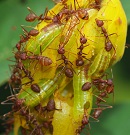
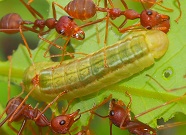
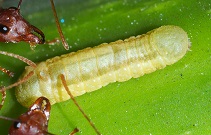

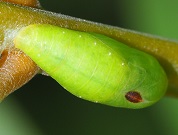
At first, I was wondering whether the caterpillars belong to Ciliate Blue butterfly (Anthene emolus goberus) or Common Tit butterfly (Hypolycaena erylus teatus) since their caterpillars looked very similar. After sighting a pupa with a dark brown spot on the same plant, I concluded that they were caterpillars of Ciliate Blue butterfly. In the Butterfly Circle website, the host plants mentioned for Ciliate Blue butterfly are Golden Showers (Cassia fistula) and Yellow Saraca (Saraca thaipingensis). Candle Bush would be a new host plant for this butterfly.
In early June, the feasting on the lone Candle Bush plant continued. There seemed to be continuous supply of caterpillars that come in different stages over the past weeks. While scanning the surrounding vegetation, I started noticing some young shoots of Sarsaparilla Vine (Smilax setosa) had been eaten by some creatures. Following the Weaver Ant trail on the vine, I began to see small caterpillars similar to the ones on the Candle Bush plant. I also found a pupa with a dark brown spot attached to the hairy stem of the vine. A Weaver Ant was even seen carrying a young caterpillar. Based on this observation, Sarsaparilla Vine appeared to be another new host plant of this caterpillar.
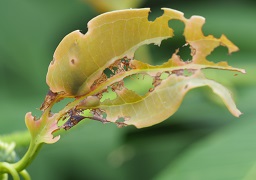
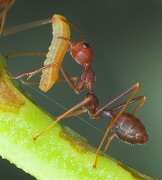
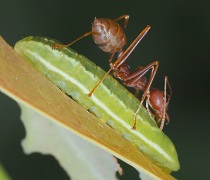

In the current nature setting, it was almost impossible to get a picture of the caterpillars alone without the presence of the ants. They were simply covering all angles around the caterpillars. This very special symbiotic relationship is known as ant-caterpillar mutualism. The ants protect the caterpillars and in return, the caterpillars secrete some sugary substances that the ants like.